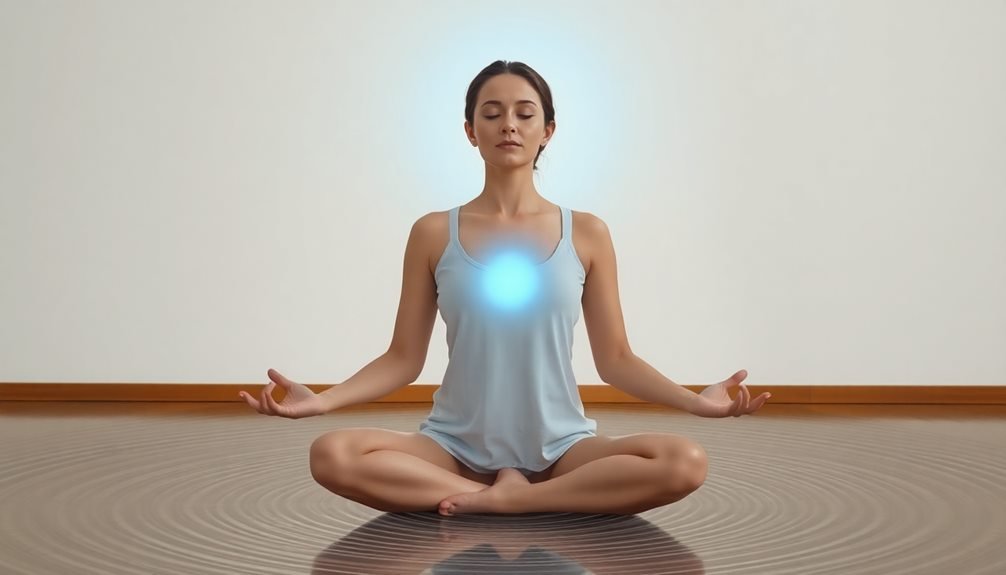Three powerful vocal techniques can help you naturally ease anxiety through sound and breath. Try resonant humming, which combines deep breathing with vocal vibrations to activate your vagus nerve and trigger relaxation. You can also practice mindful breathing through song, using familiar melodies to regulate your breath patterns and calm your nervous system. The progressive tone release method pairs sustained vowel sounds with muscle tension release, creating a natural massage effect throughout your body. These accessible techniques work by engaging your body's innate ability to shift from stress to peace – let's explore how to master each approach.
Resonant Humming for Deep Relaxation

While many relaxation techniques focus on breathing alone, resonant humming combines deep breathing with gentle vocal vibrations to create a powerful calming effect. By engaging your vocal cords in a sustained hum, you'll activate your vagus nerve, which helps regulate your body's stress response and promotes relaxation.
To practice resonant humming, find a quiet space where you won't be disturbed. Sit comfortably with your spine straight and shoulders relaxed. Take a deep breath through your nose, then close your lips and hum a single note on the exhale. You'll feel vibrations in your chest, throat, and possibly your sinuses. Let the sound flow naturally without forcing it.
Start with humming sessions of 2-3 minutes, gradually extending them to 5-10 minutes as you become more comfortable. You can experiment with different pitches to find what feels most soothing.
The key is maintaining a smooth, steady tone without straining your voice. Practice this technique when you're feeling anxious, or incorporate it into your daily meditation routine for cumulative benefits in stress reduction.
Mindful Breathing Through Song
The practice of singing mindfully offers a natural way to regulate your breath and calm your nervous system. When you're singing with awareness, you'll naturally extend your exhales and create a rhythmic breathing pattern that helps reduce anxiety. This controlled breathing activates your parasympathetic nervous system, which triggers your body's relaxation response.
To begin, choose a simple song you know well and focus on your breath as you sing. Notice how your abdomen expands on the inhale and contracts on the exhale. You don't need to be a skilled singer – the goal is to use melody as a tool for mindful breathing. Start with shorter phrases and gradually work up to longer ones as your breath control improves.
Pay attention to how your body feels during different notes. You'll find that higher notes often require more breath support, while lower notes can help ground you. If you're feeling particularly anxious, try singing in your lower register, as these frequencies can help settle your nervous system.
Remember to keep your jaw and shoulders relaxed, allowing your breath to flow freely as you combine melody with mindful awareness.
Progressive Tone Release Method

Building on mindful breathing, progressive tone release harnesses sustained vocal sounds to systematically relax your body's muscle groups. The method combines deep breathing with prolonged vowel sounds, starting from your head and working down to your toes.
Begin by choosing a comfortable vowel sound like "ahh" or "ohh." As you inhale deeply, focus on tensing one specific muscle group. When you exhale, release that sound while consciously relaxing those same muscles. You'll notice how the vibration of your voice helps dissolve tension more effectively than silent relaxation alone.
Start with your facial muscles, making the sound while releasing tension around your jaw and forehead. Move to your neck and shoulders, then progress to your chest, arms, abdomen, and legs. For each area, sustain the tone for 5-7 seconds while letting go of muscle tension.
You'll find this technique particularly effective because it engages both your nervous system and muscular awareness. The vibrations from your voice create a natural massage effect, while the systematic progression guarantees you don't miss any areas of tension.
Practice this method for 10-15 minutes daily for ideal results.
Frequently Asked Questions
Can Vocal Techniques for Anxiety Be Practiced Effectively While Driving or Commuting?
You can safely practice basic breathing and humming exercises while driving, but avoid complex vocal techniques. It's best to keep your focus on the road and save deeper anxiety-relief practices for stationary settings.
How Long Does It Take to Notice Anxiety Reduction From Vocal Exercises?
You'll likely notice initial calming effects within 5-10 minutes of vocal exercises. With regular practice, you can experience lasting anxiety reduction within 2-3 weeks of consistent daily sessions of 10-15 minutes.
Do Vocal Anxiety Techniques Work for Panic Attacks in Social Situations?
Yes, you'll find vocal techniques can help manage panic attacks in social situations. While they won't completely stop an attack, they'll help you regain control through focused breathing and grounding exercises.
Should Vocal Exercises Be Done Before or After Taking Anti-Anxiety Medication?
You should check with your doctor about timing vocal exercises with medications. Generally, you'll want to do them when you're most anxious, regardless of medication schedule, as they're safe to combine.
Can These Vocal Techniques Help With Anxiety-Induced Sleep Problems?
Yes, you'll find that calming vocal exercises like humming, deep breathing, and gentle toning can help relax your mind and body before bed, making it easier to drift off despite anxiety-related sleep issues.
In Summary
You've now learned three powerful vocal techniques to help manage anxiety naturally. By incorporating resonant humming, mindful singing breaths, and progressive tone release into your daily routine, you're giving yourself effective tools for stress relief. Whether you're feeling overwhelmed at work or anxious at home, these vocal exercises can help you find calm. Remember, your voice isn't just for speaking – it's a powerful instrument for healing.





Leave a Reply